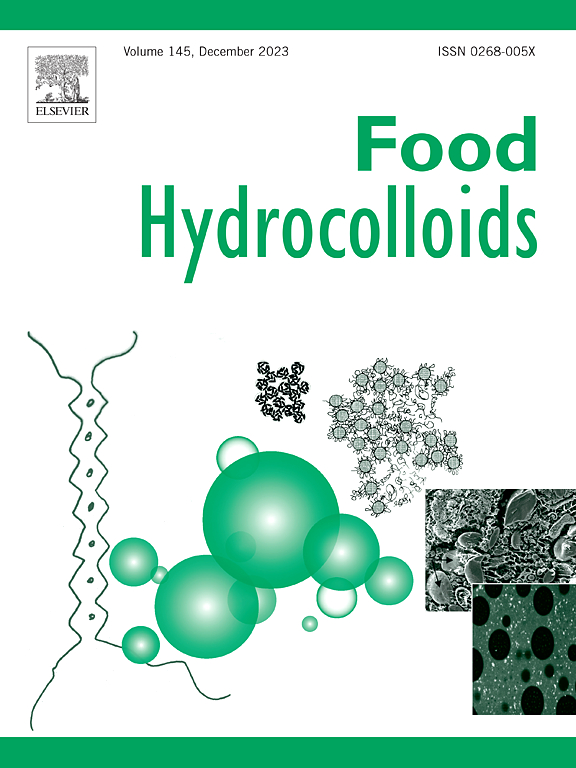Influence of extrusion processing conditions on fibrous structure, texture, and digestibility of plant-based meat analogues incorporating faba bean protein and brewers’ spent grain
IF 11
1区 农林科学
Q1 CHEMISTRY, APPLIED
引用次数: 0
Abstract
High-moisture extrusion is the most cost-effective method for producing meat analogues with desired microstructure and textural characteristics, owing to its combined unit operations and customisable process conditions. An appropriate combination of extrusion conditions is crucial for obtaining high-moisture meat analogue (HMMA) products with the desired characteristics. In this study, we systematically investigated the effects of varying extrusion conditions, specifically temperature (130–160 °C) and screw speed (100–300 rpm), on the formation of fibrous structure of faba bean protein-based HMMA in the presence of brewers’ spent grain. Our findings indicate that higher screw speeds and temperatures significantly enhanced the phase separation, physical cross-linking, and fibrous structure formation, which improved textural attributes and increased water retention capacity. Importantly, the fibrous structure achieved through adjusting extrusion conditions did not adversely affect the digestibility of faba bean protein-based HMMA. By reporting the efficacy of the extrusion conditions in structuring fibrous meat analogues similar to chicken meat, this study demonstrates that a high-quality meat alternative product can be efficiently produced using two sustainable ingredients (faba bean protein and brewers’ spent grain) without any external modifiers.

挤压加工条件对含蚕豆蛋白和啤酒废粮的植物性肉类类似物纤维结构、质地和消化率的影响
由于其组合单元操作和可定制的工艺条件,高水分挤压是生产具有所需微观结构和质地特征的肉类类似物的最具成本效益的方法。挤出条件的适当组合对于获得具有所需特性的高水分肉类模拟物(HMMA)产品至关重要。在这项研究中,我们系统地研究了不同的挤压条件,特别是温度(130-160°C)和螺杆转速(100-300 rpm),对啤酒废粒存在下蚕豆蛋白基HMMA纤维结构形成的影响。研究结果表明,较高的螺杆转速和温度显著增强了相分离、物理交联和纤维结构的形成,从而改善了结构属性,提高了保水能力。重要的是,通过调整挤压条件获得的纤维结构不会对蚕豆蛋白基HMMA的消化率产生不利影响。通过报告挤压条件在构建类似鸡肉的纤维肉类似物中的功效,本研究表明,在不使用任何外部改性剂的情况下,使用两种可持续成分(蚕豆蛋白和啤酒酿造者的废谷物)可以有效地生产出高质量的肉类替代品。
本文章由计算机程序翻译,如有差异,请以英文原文为准。
求助全文
约1分钟内获得全文
求助全文
来源期刊

Food Hydrocolloids
工程技术-食品科技
CiteScore
19.90
自引率
14.00%
发文量
871
审稿时长
37 days
期刊介绍:
Food Hydrocolloids publishes original and innovative research focused on the characterization, functional properties, and applications of hydrocolloid materials used in food products. These hydrocolloids, defined as polysaccharides and proteins of commercial importance, are added to control aspects such as texture, stability, rheology, and sensory properties. The research's primary emphasis should be on the hydrocolloids themselves, with thorough descriptions of their source, nature, and physicochemical characteristics. Manuscripts are expected to clearly outline specific aims and objectives, include a fundamental discussion of research findings at the molecular level, and address the significance of the results. Studies on hydrocolloids in complex formulations should concentrate on their overall properties and mechanisms of action, while simple formulation development studies may not be considered for publication.
The main areas of interest are:
-Chemical and physicochemical characterisation
Thermal properties including glass transitions and conformational changes-
Rheological properties including viscosity, viscoelastic properties and gelation behaviour-
The influence on organoleptic properties-
Interfacial properties including stabilisation of dispersions, emulsions and foams-
Film forming properties with application to edible films and active packaging-
Encapsulation and controlled release of active compounds-
The influence on health including their role as dietary fibre-
Manipulation of hydrocolloid structure and functionality through chemical, biochemical and physical processes-
New hydrocolloids and hydrocolloid sources of commercial potential.
The Journal also publishes Review articles that provide an overview of the latest developments in topics of specific interest to researchers in this field of activity.
 求助内容:
求助内容: 应助结果提醒方式:
应助结果提醒方式:


